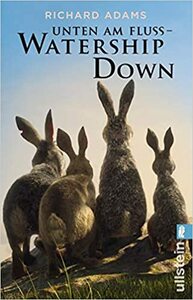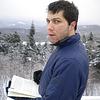You need to sign in or sign up before continuing.
Take a photo of a barcode or cover
Another classic I did not read until much later in life, and I feel I'm all the luckier for it. Sure, it's about rabbits -- which is about as much as I think you can expect a 15-year-old to take from it, dooming it to be forever grossly under-appreciated. As far as allegories go, this novel is almost too rich for an undergraduate curriculum. Many readers would put this novel and Animal Farm in the same category, which is a bit unfair to both. The commentary in this novel is buried much deeper than those in Animal Farm and as such require not just the skill of recognizing such parallels in the midst of a beautifully written text, but also of interpreting what's really being implied -- an endeavor that can take an infinite number of paths. This is not to say Animal Farm is a "worse" book, but rather that readers who may view Animal Farm as a stepping stone into allegorical storytelling and are looking for something more challenging, and something that can be picked through, analyzed and debated for hours on end, shouldn't be without Watership Down on their "To Read" list -- arguably more than once.
adventurous
challenging
emotional
hopeful
medium-paced
Plot or Character Driven:
Character
Strong character development:
Yes
Loveable characters:
Yes
Diverse cast of characters:
Complicated
Flaws of characters a main focus:
No
adventurous
slow-paced
Diverse cast of characters:
No
adventurous
emotional
hopeful
mysterious
reflective
tense
medium-paced
Plot or Character Driven:
Plot
Strong character development:
Yes
Loveable characters:
Yes
Diverse cast of characters:
No
Flaws of characters a main focus:
No
adventurous
funny
hopeful
inspiring
sad
medium-paced
Plot or Character Driven:
Plot
Strong character development:
Yes
Loveable characters:
Complicated
Diverse cast of characters:
Yes
Flaws of characters a main focus:
Complicated
adventurous
emotional
lighthearted
tense
medium-paced
Plot or Character Driven:
A mix
Strong character development:
No
Loveable characters:
Yes
Diverse cast of characters:
Yes
Flaws of characters a main focus:
No
adventurous
dark
tense
Strong character development:
Complicated
Loveable characters:
Complicated
Diverse cast of characters:
No
Flaws of characters a main focus:
Yes
Graphic: Animal death, Misogyny, Violence, Blood, Injury/Injury detail
What could be more difficult than imagining what the world must look like through the eyes of an animal? That is the challenge this author takes up, and executes remarkably effectively, in [b:Watership Down|76620|Watership Down (Watership Down, #1)|Richard Adams|https://i.gr-assets.com/images/S/compressed.photo.goodreads.com/books/1405136931l/76620._SY75_.jpg|1357456]. When read purely as a young adult fantasy novel, it's very dark and entertaining, and engaging. When read as an experimental writing challenge to imagine what animal cognition must be like, at least in terms accessible to us, it's quite a feat of both science and imagination.
For example, I love the scene in Cowslip's warren when Strawberry shows Hazel the "shape" of El-arairah. It reminded me of the moment in our prehistory when we first made cave paintings. Almost undoubtedly, in the beginning only a handful of people--if you can even call them that--probably understood the concept, the vast majority just staring blankly, resisting all explanation. What struck me in particular in this book is who made the "shape" but those from the warren in which everybody is big, fat, and happy by virtue of being fed. They expend no mental energy in hunting and gathering and hiding and defending, thus unlocking more potential to "discover" art. This is at the heart of such ideas as Maslow's hierarchy of needs and the division of labor, and probably strikes pretty closely to the unseen and unseeable moments in our animal prehistory.
Like all great fairy tales, this one is dark and violent. I don't know when we strayed from that path and started to believe that stories had to be "sanitized" for the consumption of children. This book holds onto that older tradition by which stories are told in a physically and psychologically jarring way, not for the sake of spectacle, but to effect deeper, rawer emotion.
For example, I love the scene in Cowslip's warren when Strawberry shows Hazel the "shape" of El-arairah. It reminded me of the moment in our prehistory when we first made cave paintings. Almost undoubtedly, in the beginning only a handful of people--if you can even call them that--probably understood the concept, the vast majority just staring blankly, resisting all explanation. What struck me in particular in this book is who made the "shape" but those from the warren in which everybody is big, fat, and happy by virtue of being fed. They expend no mental energy in hunting and gathering and hiding and defending, thus unlocking more potential to "discover" art. This is at the heart of such ideas as Maslow's hierarchy of needs and the division of labor, and probably strikes pretty closely to the unseen and unseeable moments in our animal prehistory.
Like all great fairy tales, this one is dark and violent. I don't know when we strayed from that path and started to believe that stories had to be "sanitized" for the consumption of children. This book holds onto that older tradition by which stories are told in a physically and psychologically jarring way, not for the sake of spectacle, but to effect deeper, rawer emotion.
adventurous
mysterious
medium-paced
Plot or Character Driven:
Plot
Strong character development:
No
Loveable characters:
Yes
Diverse cast of characters:
Yes
Flaws of characters a main focus:
No
The joy of storytelling. That is the single greatest strength of this book. You feel the enjoyment of the author and you enjoy it in turn. It isn’t a deep or complex story. The themes of freedom vs. risk and mankind’s industrialisation vs. nature are present, but they are fairly superficial and not the focus of the story.
A great aspect of the book is the way it takes the perspective of rabbits seriously. Every plot point and character trait is seeped in and constrained by the nature of rabbits. Together with the gentle and beautiful descriptions of nature, the story becomes full of the same wonder as unknown worlds of fantasy and science fiction.
The story isn’t without its weaknesses. Besides the main characters, most rabbits are quite one-dimensional. The smart one, the fast one etc. They still exist and make sense within the world of rabbits but lack the inner workings of the likes of Hazel and Bigwig.
Also many of the challenges are overcome by the slyness of the rabbits. This is a theme, but also becomes a cop out, since the author makes the rabbits smart or dumb enough to fit the stories. A point is being made repeatedly in the book about their inability to understand complex physics or human behaviours. So suddenly becoming smart enough to figure something out, feels like deus machina by the fifth time it happens.
But all that doesn’t matter when it is such a joy to read!
A great aspect of the book is the way it takes the perspective of rabbits seriously. Every plot point and character trait is seeped in and constrained by the nature of rabbits. Together with the gentle and beautiful descriptions of nature, the story becomes full of the same wonder as unknown worlds of fantasy and science fiction.
The story isn’t without its weaknesses. Besides the main characters, most rabbits are quite one-dimensional. The smart one, the fast one etc. They still exist and make sense within the world of rabbits but lack the inner workings of the likes of Hazel and Bigwig.
Also many of the challenges are overcome by the slyness of the rabbits. This is a theme, but also becomes a cop out, since the author makes the rabbits smart or dumb enough to fit the stories. A point is being made repeatedly in the book about their inability to understand complex physics or human behaviours. So suddenly becoming smart enough to figure something out, feels like deus machina by the fifth time it happens.
But all that doesn’t matter when it is such a joy to read!





